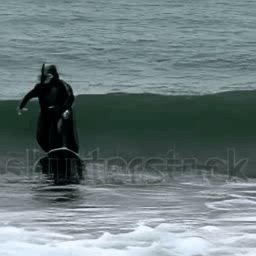Diffusers documentation
Text-to-video synthesis
This pipeline is for research purposes only.
Text-to-video synthesis
Overview
VideoFusion: Decomposed Diffusion Models for High-Quality Video Generation by Zhengxiong Luo, Dayou Chen, Yingya Zhang, Yan Huang, Liang Wang, Yujun Shen, Deli Zhao, Jingren Zhou, Tieniu Tan.
The abstract of the paper is the following:
A diffusion probabilistic model (DPM), which constructs a forward diffusion process by gradually adding noise to data points and learns the reverse denoising process to generate new samples, has been shown to handle complex data distribution. Despite its recent success in image synthesis, applying DPMs to video generation is still challenging due to high-dimensional data spaces. Previous methods usually adopt a standard diffusion process, where frames in the same video clip are destroyed with independent noises, ignoring the content redundancy and temporal correlation. This work presents a decomposed diffusion process via resolving the per-frame noise into a base noise that is shared among all frames and a residual noise that varies along the time axis. The denoising pipeline employs two jointly-learned networks to match the noise decomposition accordingly. Experiments on various datasets confirm that our approach, termed as VideoFusion, surpasses both GAN-based and diffusion-based alternatives in high-quality video generation. We further show that our decomposed formulation can benefit from pre-trained image diffusion models and well-support text-conditioned video creation.
Resources:
Available Pipelines:
| Pipeline | Tasks | Demo |
|---|---|---|
| TextToVideoSDPipeline | Text-to-Video Generation | 🤗 Spaces |
Usage example
Let’s start by generating a short video with the default length of 16 frames (2s at 8 fps):
import torch
from diffusers import DiffusionPipeline
from diffusers.utils import export_to_video
pipe = DiffusionPipeline.from_pretrained("damo-vilab/text-to-video-ms-1.7b", torch_dtype=torch.float16, variant="fp16")
pipe = pipe.to("cuda")
prompt = "Spiderman is surfing"
video_frames = pipe(prompt).frames
video_path = export_to_video(video_frames)
video_pathDiffusers supports different optimization techniques to improve the latency and memory footprint of a pipeline. Since videos are often more memory-heavy than images, we can enable CPU offloading and VAE slicing to keep the memory footprint at bay.
Let’s generate a video of 8 seconds (64 frames) on the same GPU using CPU offloading and VAE slicing:
import torch
from diffusers import DiffusionPipeline
from diffusers.utils import export_to_video
pipe = DiffusionPipeline.from_pretrained("damo-vilab/text-to-video-ms-1.7b", torch_dtype=torch.float16, variant="fp16")
pipe.enable_model_cpu_offload()
# memory optimization
pipe.enable_vae_slicing()
prompt = "Darth Vader surfing a wave"
video_frames = pipe(prompt, num_frames=64).frames
video_path = export_to_video(video_frames)
video_pathIt just takes 7 GBs of GPU memory to generate the 64 video frames using PyTorch 2.0, “fp16” precision and the techniques mentioned above.
We can also use a different scheduler easily, using the same method we’d use for Stable Diffusion:
import torch
from diffusers import DiffusionPipeline, DPMSolverMultistepScheduler
from diffusers.utils import export_to_video
pipe = DiffusionPipeline.from_pretrained("damo-vilab/text-to-video-ms-1.7b", torch_dtype=torch.float16, variant="fp16")
pipe.scheduler = DPMSolverMultistepScheduler.from_config(pipe.scheduler.config)
pipe.enable_model_cpu_offload()
prompt = "Spiderman is surfing"
video_frames = pipe(prompt, num_inference_steps=25).frames
video_path = export_to_video(video_frames)
video_pathHere are some sample outputs:
 |
 |
Available checkpoints
TextToVideoSDPipeline
class diffusers.TextToVideoSDPipeline
< source >( vae: AutoencoderKL text_encoder: CLIPTextModel tokenizer: CLIPTokenizer unet: UNet3DConditionModel scheduler: KarrasDiffusionSchedulers )
Parameters
- vae (AutoencoderKL) — Variational Auto-Encoder (VAE) Model to encode and decode images to and from latent representations.
-
text_encoder (
CLIPTextModel) — Frozen text-encoder. Same as Stable Diffusion 2. -
tokenizer (
CLIPTokenizer) — Tokenizer of class CLIPTokenizer. - unet (UNet3DConditionModel) — Conditional U-Net architecture to denoise the encoded video latents.
-
scheduler (SchedulerMixin) —
A scheduler to be used in combination with
unetto denoise the encoded image latents. Can be one of DDIMScheduler, LMSDiscreteScheduler, or PNDMScheduler.
Pipeline for text-to-video generation.
This model inherits from DiffusionPipeline. Check the superclass documentation for the generic methods the library implements for all the pipelines (such as downloading or saving, running on a particular device, etc.)
__call__
< source >(
prompt: typing.Union[str, typing.List[str]] = None
height: typing.Optional[int] = None
width: typing.Optional[int] = None
num_frames: int = 16
num_inference_steps: int = 50
guidance_scale: float = 9.0
negative_prompt: typing.Union[str, typing.List[str], NoneType] = None
eta: float = 0.0
generator: typing.Union[torch._C.Generator, typing.List[torch._C.Generator], NoneType] = None
latents: typing.Optional[torch.FloatTensor] = None
prompt_embeds: typing.Optional[torch.FloatTensor] = None
negative_prompt_embeds: typing.Optional[torch.FloatTensor] = None
output_type: typing.Optional[str] = 'np'
return_dict: bool = True
callback: typing.Union[typing.Callable[[int, int, torch.FloatTensor], NoneType], NoneType] = None
callback_steps: int = 1
cross_attention_kwargs: typing.Union[typing.Dict[str, typing.Any], NoneType] = None
)
→
~pipelines.stable_diffusion.TextToVideoSDPipelineOutput or tuple
Parameters
-
prompt (
strorList[str], optional) — The prompt or prompts to guide the video generation. If not defined, one has to passprompt_embeds. instead. -
height (
int, optional, defaults to self.unet.config.sample_size * self.vae_scale_factor) — The height in pixels of the generated video. -
width (
int, optional, defaults to self.unet.config.sample_size * self.vae_scale_factor) — The width in pixels of the generated video. -
num_frames (
int, optional, defaults to 16) — The number of video frames that are generated. Defaults to 16 frames which at 8 frames per seconds amounts to 2 seconds of video. -
num_inference_steps (
int, optional, defaults to 50) — The number of denoising steps. More denoising steps usually lead to a higher quality videos at the expense of slower inference. -
guidance_scale (
float, optional, defaults to 7.5) — Guidance scale as defined in Classifier-Free Diffusion Guidance.guidance_scaleis defined aswof equation 2. of Imagen Paper. Guidance scale is enabled by settingguidance_scale > 1. Higher guidance scale encourages to generate videos that are closely linked to the textprompt, usually at the expense of lower video quality. -
negative_prompt (
strorList[str], optional) — The prompt or prompts not to guide the video generation. If not defined, one has to passnegative_prompt_embedsinstead. Ignored when not using guidance (i.e., ignored ifguidance_scaleis less than1). -
eta (
float, optional, defaults to 0.0) — Corresponds to parameter eta (η) in the DDIM paper: https://arxiv.org/abs/2010.02502. Only applies to schedulers.DDIMScheduler, will be ignored for others. -
generator (
torch.GeneratororList[torch.Generator], optional) — One or a list of torch generator(s) to make generation deterministic. -
latents (
torch.FloatTensor, optional) — Pre-generated noisy latents, sampled from a Gaussian distribution, to be used as inputs for video generation. Can be used to tweak the same generation with different prompts. If not provided, a latents tensor will ge generated by sampling using the supplied randomgenerator. Latents should be of shape(batch_size, num_channel, num_frames, height, width). -
prompt_embeds (
torch.FloatTensor, optional) — Pre-generated text embeddings. Can be used to easily tweak text inputs, e.g. prompt weighting. If not provided, text embeddings will be generated frompromptinput argument. -
negative_prompt_embeds (
torch.FloatTensor, optional) — Pre-generated negative text embeddings. Can be used to easily tweak text inputs, e.g. prompt weighting. If not provided, negative_prompt_embeds will be generated fromnegative_promptinput argument. -
output_type (
str, optional, defaults to"np") — The output format of the generate video. Choose betweentorch.FloatTensorornp.array. -
return_dict (
bool, optional, defaults toTrue) — Whether or not to return a~pipelines.stable_diffusion.TextToVideoSDPipelineOutputinstead of a plain tuple. -
callback (
Callable, optional) — A function that will be called everycallback_stepssteps during inference. The function will be called with the following arguments:callback(step: int, timestep: int, latents: torch.FloatTensor). -
callback_steps (
int, optional, defaults to 1) — The frequency at which thecallbackfunction will be called. If not specified, the callback will be called at every step. -
cross_attention_kwargs (
dict, optional) — A kwargs dictionary that if specified is passed along to theAttentionProcessoras defined underself.processorin diffusers.cross_attention.
Returns
~pipelines.stable_diffusion.TextToVideoSDPipelineOutput or tuple
~pipelines.stable_diffusion.TextToVideoSDPipelineOutput if return_dict is True, otherwise a `tuple.
When returning a tuple, the first element is a list with the generated frames.
Function invoked when calling the pipeline for generation.
Examples:
>>> import torch
>>> from diffusers import TextToVideoSDPipeline
>>> from diffusers.utils import export_to_video
>>> pipe = TextToVideoSDPipeline.from_pretrained(
... "damo-vilab/text-to-video-ms-1.7b", torch_dtype=torch.float16, variant="fp16"
... )
>>> pipe.enable_model_cpu_offload()
>>> prompt = "Spiderman is surfing"
>>> video_frames = pipe(prompt).frames
>>> video_path = export_to_video(video_frames)
>>> video_pathDisable sliced VAE decoding. If enable_vae_slicing was previously invoked, this method will go back to
computing decoding in one step.
Disable tiled VAE decoding. If enable_vae_tiling was previously invoked, this method will go back to
computing decoding in one step.
Offloads all models to CPU using accelerate, reducing memory usage with a low impact on performance. Compared
to enable_sequential_cpu_offload, this method moves one whole model at a time to the GPU when its forward
method is called, and the model remains in GPU until the next model runs. Memory savings are lower than with
enable_sequential_cpu_offload, but performance is much better due to the iterative execution of the unet.
Offloads all models to CPU using accelerate, significantly reducing memory usage. When called, unet,
text_encoder, vae have their state dicts saved to CPU and then are moved to a torch.device('meta') and loaded to GPU only when their specific submodule has its forwardmethod called. Note that offloading happens on a submodule basis. Memory savings are higher than withenable_model_cpu_offload`, but performance is lower.
Enable sliced VAE decoding.
When this option is enabled, the VAE will split the input tensor in slices to compute decoding in several steps. This is useful to save some memory and allow larger batch sizes.
Enable tiled VAE decoding.
When this option is enabled, the VAE will split the input tensor into tiles to compute decoding and encoding in several steps. This is useful to save a large amount of memory and to allow the processing of larger images.